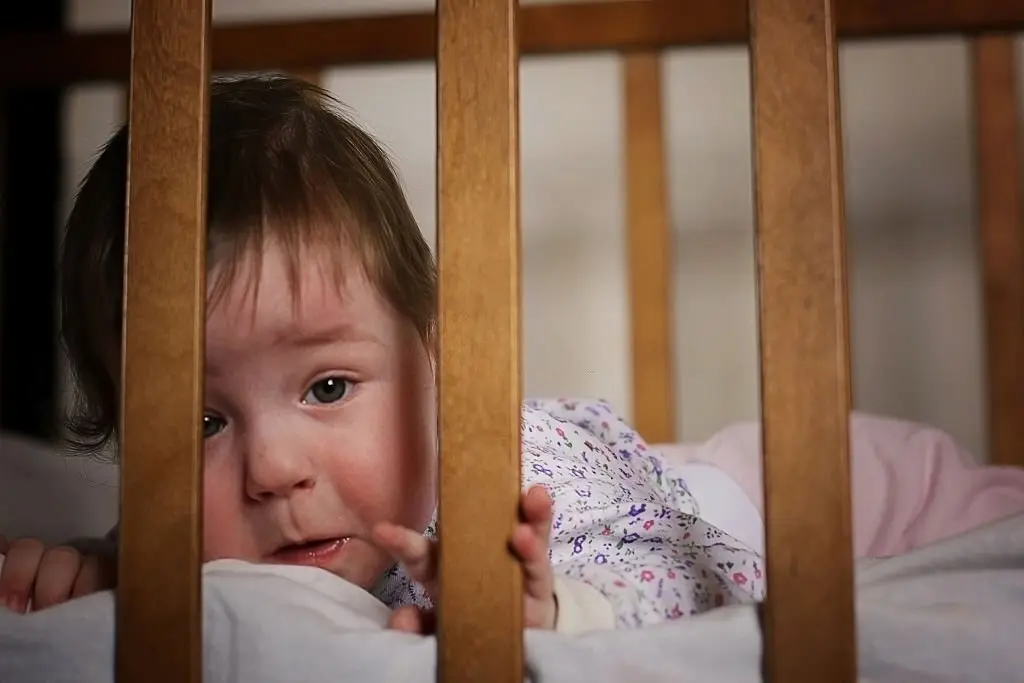How to Prevent Baby From Hitting Head on Crib

Introduction to how to prevent baby from hitting head on crib
Ensuring your baby’s safety during sleep is a top priority for every parent. This includes controlling your child from hitting their head on the crib.
In this guide, we’ll discuss practical strategies on how to prevent baby from hitting head on crib and answer pressing questions you may have concerning crib safety.
Understanding the behavior: Why do babies hit their heads?

Before we delve into preventive measures, it’s crucial to understand why babies hit their heads. Infants often move around in their sleep and may bump their heads against the crib’s sides.
This behavior is generally due to restlessness or discomfort and, although alarming for parents, is common.
Effective strategies: Keeping your baby safe in the crib
Creating a safe sleeping environment for your baby is paramount. Minimizing the crib’s clutter, ensuring a snug-fitting mattress, and maintaining an appropriate crib sheet can prevent your child from hitting their head.
Regular monitoring of your baby’s movements during sleep will also help you gauge if further preventive measures are required.
Preventing bumps: The best way to protect a baby’s head
The best way to safeguard your child from crib-related bumps is to ensure that the crib meets current safety standards.
This includes a firm mattress, no drop-side rails, and slats that are no wider than 2-3/8 inches apart. Investing in a crib with rounded corners can further minimize the risk of injury.
Avoiding falls: Keeping your baby Inside the crib.
It’s not uncommon for babies to try and climb out of their cribs. To prevent this, adjust the crib’s mattress to the lowest level once your baby can sit unassisted. Additionally, removing items that could assist in climbing, like large toys or crib bumpers, is advisable.
Pillow safety: The risk and benefits
While it may seem like a pillow could protect your baby’s head from bumps, using pillows in a crib for babies under 12 months is highly discouraged due to the risk of suffocation. If you use a pad for older babies, ensure it is thin, firm, and kept away from the crib’s sides.
Addressing head banging: Ways to handle this behavior
Head banging can be concerning, but it’s often a self-soothing behavior. If your child is consistently banging their head, it’s important to:
- Stay Calm: Initially, try not to overreact. It’s usually a phase that passes with time.
- Adjust the Environment: Move the crib away from the walls and secure the crib’s side rails.
- Prevent Injury: Ensure the crib environment is safe by meeting safety standards.
The Crib bumper debate: Are they safe?
Crib bumpers may seem like a viable solution to prevent head bumps. However, they’ve been linked to SIDS (Sudden Infant Death Syndrome) due to the risk of suffocation. It’s best to consult with a pediatrician before using these products.
Exploring additional measures: Extra precautions to keep your baby safe
Further steps can be adopted to ensure your baby’s safety in their crib.
Crib placement: An Important safety sector
Place your baby’s crib away from windows and blinds. The cords from window treatments could pose a choking hazard. Additionally, ensure that the crib is away from furniture that your baby could climb onto.
Soothing Techniques: Aiding Restful Sleep
Often, babies move a lot in their cribs due to restlessness. Establishing a calming bedtime routine can soothe your baby, promoting more restful sleep. This could include a warm bath, soft music, or gentle rocking.
Safe Sleepwear: Minimizing Risks
Choose sleepwear designed to keep your baby safe and comfortable. Opt for well-fitted, flame-resistant pajamas, and avoid clothes with drawstrings, which could potentially cause choking.
Familiarize Yourself with Infant CPR and First Aid
While we hope you never need it, being familiar with infant CPR and first aid can be invaluable in a crisis. Many organizations offer courses, and it’s a worthwhile skill set for any parent.
Periodic Safety Checks: Essential for Continuous Safety
As your baby grows, so do their needs and capabilities. Regularly checking the crib’s integrity and adjusting the environment for your baby’s changing abilities is crucial.
Keeping the Crib Clear: Avoiding Unnecessary Items
While stuffed animals, blankets, and bumpers may make the crib look cozy, they increase the risk of suffocation and should be avoided. The crib should contain a firm mattress with a snug-fitted sheet until your baby is 12 months old.
Consider Transitioning to a Toddler Bed
When your baby grows into a toddler, they might be ready for a transition to a toddler bed, especially if they have learned how to climb. A toddler bed is lower to the ground and eliminates the risk of injury from climbing out of the crib.
Remember, safety doesn’t happen by accident. It’s the result of careful planning and vigilance. Always prioritize your child’s safety, and don’t hesitate to consult with a healthcare professional if you’re ever unsure about a product or practice. Your baby’s well-being and your peace of mind are well worth the effort.
Conclusion on how to prevent baby from hitting head on crib
While it can be tempting to adorn your baby’s crib with plush pillows and bumpers, it’s essential to prioritize safety over aesthetics. Simple measures, like ensuring the crib meets safety standards and monitoring your child’s behavior, can significantly reduce the risk of head bumps.
Also Read:
- How do You Turn a Closet into a Nursery
- Mastering Comfort: The Definitive Guide How To Make Baby More Comfortable In Crib
- How To Convert Baby Cache Crib To Toddler Bed: A Comprehensive Guide
- When To Move Baby To Crib : A Comprehensive Guide
FAQs How to prevent baby from hitting head on crib
It’s important to remember that not all products sold in stores are safe or suitable for all ages. Retailers sell these items because of demand, but it’s up to individual parents to make informed decisions regarding their child’s safety.
If your newborn bumps their head, don’t panic. Observe them for any changes in behavior, such as vomiting, unusual sleepiness, or difficulty feeding. If these signs present themselves, contact a healthcare professional immediately.
Head banging is often a self-soothing behavior in toddlers. Distract your child with a comforting routine or soft music. If the behavior continues or seems excessive, consult a healthcare professional.
Head banging is often a self-soothing behavior in toddlers. Distract your child with a comforting routine or soft music. If the behavior continues or seems excessive, consult a healthcare professional.
If your baby falls and hits their head, monitor them for any unusual behavior or symptoms like lethargy, vomiting, or changes in feeding habits. If these occur, seek immediate medical attention.
Crib bumpers are not recommended for babies under 12 months due to the risk of suffocation and SIDS. It’s best to consult your pediatrician for personalized advice.
While it can be concerning for parents, it’s fairly common for babies to bump their heads on the crib due to their explorative nature. However, if it’s frequent or distressing to your baby, it’s worth discussing with a pediatrician.
Crib bumpers are padded fabrics that surround the inside of the crib, while crib liners are often mesh materials designed to keep your baby’s limbs from getting stuck between the crib’s slats. Despite the differences, both have been associated with risks, and their use should be thoroughly researched and discussed with a healthcare professional.
Remember, while it’s natural to worry about your baby’s safety, informed and vigilant care can help keep them safe and secure. When in doubt, always consult with a healthcare professional.
